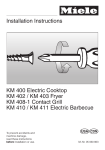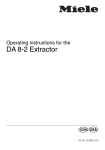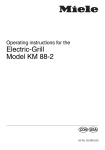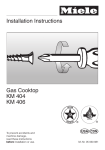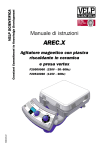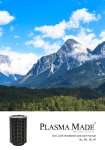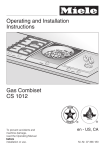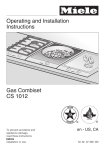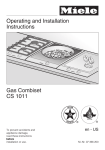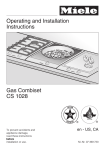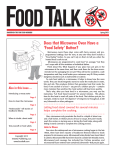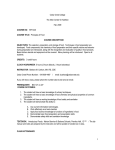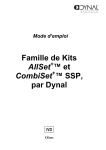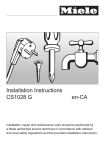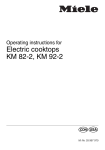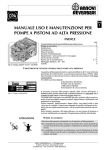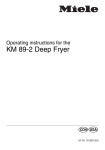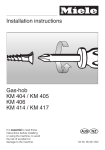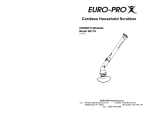Download Miele KM 93-2 User's Manual
Transcript
Operating instructions for Gas cooktops KM 83-2, KM 93-2 CANADIAN GAS ASSOCIATION R APROVED ]ö M.-Nr. 03 998 090 Description of the appliance Description of the appliance KM 83-2 5 4 6 3 7 8 2 9 1 10 12 11 KM 93-2 4 3 5 6 7 2 8 1 9 10 11 2 15 14 13 12 Description of the appliance Description of the appliance KM 83-2 b Control panel c Normal burner n Control for the rear right burner o Control for the rear left burner p Control for the front left burner d Fast burner e Pan support f Ring support for the Normal burner g Burner cap h Ignitor i Ignition safety control j Burner head k Cable for connection to electrical supply approx. 3.6 ft (1.10 m) long. l Control for front burner m Control for rear burner KM 93-2 b Control panel c Normal burner d Pan support e Ring support for the normal burner f Burner cap g Ignitor h Ignition safety control i Burner head j Fast burner k Normal burner l Cable for connection Data plate Because the data plate is no longer visible once the appliance has been installed, a 2nd data plate is supplied which should be placed into the space provided on page 15 of these instructions. Special accessories Special accessories are available from your Miele Dealer or from the Miele Parts Department. Stainless steel cover EA 80 A stainless steel cover is available for the KM 83-2 cooktop. Check availability in each country. For installation of the cover, a minimum distance of 20" (510 mm) is required between the countertop and wall cabinets. Note: The pan support must be removed before lowering the stainless steel cover (EA80). Do not install the DA 8-2 directly next to the gas hob. to electrical supply, approx. 3.6 ft (1.10 m) long m Control for the front right burner 3 For your safety For your safety WARNING: If the information in this manual is not followed exactly, a fire or explosion may result causing property damage, personal injury or death. Do not store or use gasoline or other flammable vapors and liquids in the vicinity of this or any other appliance. WHAT TO DO IF YOU SMELL GAS – Do not try to light any appliance. – Do not touch any electrical switch; do not use any phone in your building. – Immediately call your gas supplier from a neighbor’s phone. Follow the gas supplier’s instructions. – If you cannot reach your gas supplier, call the fire department. Installation and service must be performed by a qualified installer, service agency or the gas supplier. 4 Note to the installer (CDN and USA) LEAVE THESE INSTRUCTIONS WITH THE CONSUMER. The appliance and its individual shutoff valve must be disconnected from the gas supply piping system during any pressure testing of that system at test pressures in excess of 1/2 psi (3.5 kPa). The appliance must be isolated from the gas supply piping system by closing its individual manual shutoff valve during any pressure testing of the gas supply piping system at test pressures equal to or less than 1/2 psi (3.5 kPa). For Canada only: The minimum supply pressure for checking the regulator setting shall be 5 inches water column (1246 Pa), which is 1 inch water column (249 Pa) above the manifold pressure of 4 inches water column (996 Pa). Help protect our environment Help protect our environment Disposal of packaging The transport and protective packing is mostly manufactured from the following re-usable materials: – Corrugated paper / card board mostly from recycled materials. – Polyethylene foil (PE) partly from secondary raw materials. Rather than throwing these materials away, please take them to the nearest recycling center for specific waste. Disposal of your old machine Old machines contain materials which can be recycled. Please contact your local recycling center or scrap merchant about potential recycling programs, before disposing of the appliance. Read the notes on page 8 before disposing of the appliance. 5 Contents Contents Description of the appliance . . . . . . . . . . . . . . . . . . . . . . . . . . . . . . . . . . . . . . . . . 2 For your safety . . . . . . . . . . . . . . . . . . . . . . . . . . . . . . . . . . . . . . . . . . . . . . . . . . . . 4 Help protect our environment . . . . . . . . . . . . . . . . . . . . . . . . . . . . . . . . . . . . . . . . 5 Warning and Safety Instructions . . . . . . . . . . . . . . . . . . . . . . . . . . . . . . . . . . . . . 7 Using the cooktop Burner controls. . . . . . . . . . . . . . . . . . . . . . . . . . . . . . . . . . . . . . . . . . . . . . . . . . . . Instructions for using the gas burners . . . . . . . . . . . . . . . . . . . . . . . . . . . . . . . . . . Power outage . . . . . . . . . . . . . . . . . . . . . . . . . . . . . . . . . . . . . . . . . . . . . . . . . . . . . Suitable pans . . . . . . . . . . . . . . . . . . . . . . . . . . . . . . . . . . . . . . . . . . . . . . . . . . . . . 10 10 11 12 Cleaning and care . . . . . . . . . . . . . . . . . . . . . . . . . . . . . . . . . . . . . . . . . . . . . . . . 13 Problem solving guide. . . . . . . . . . . . . . . . . . . . . . . . . . . . . . . . . . . . . . . . . . . . . 15 After Sales Service. . . . . . . . . . . . . . . . . . . . . . . . . . . . . . . . . . . . . . . . . . . . . . . . 16 Electrical connection . . . . . . . . . . . . . . . . . . . . . . . . . . . . . . . . . . . . . . . . . . . . . . 17 Gas connection . . . . . . . . . . . . . . . . . . . . . . . . . . . . . . . . . . . . . . . . . . . . . . . . . . 18 Appliance dimensions . . . . . . . . . . . . . . . . . . . . . . . . . . . . . . . . . . . . . . . . . . . . . 19 Installation instructions. . . . . . . . . . . . . . . . . . . . . . . . . . . . . . . . . . . . . . . . . . . . 21 Conversion to alternative types of gas . . . . . . . . . . . . . . . . . . . . . . . . . . . . . . . 24 6 Warning and Safety Instructions Warning and Safety Instructions Important safety instructions Warning: When using your cooktop, follow basic safety precautions including the following: Read all instructions before using the cooktop. Use the cooktop only for its intended purpose. Do not use the cooktop unless all parts are properly in place according to the installation and operating instructions. Before servicing, disconnect the power supply by removing the fuse or tripping the circuit breaker. The electrical safety of this appliance can only be guaranteed when continuity is complete between the appliance and an effective grounding system. It is imperative that this basic safety requirement is met. If there is any doubt, have the electrical system of the house checked by a qualified electrician. The manufacturer cannot be held responsible for damage caused by the lack or inadequacy of an effective grounding system. Store all toys away from the cooktop to prevent injury to curious or playful children. Please remember that, in use, burners and pot racks become hot. Ensure that children do not touch them. Do not let cooking grease or other flammable materials accumulate on the cooktop. Allow sufficient time for the burners to cool before touching or exposing surface areas to flammable materials. Always cook pork thoroughly to ensure that, in the event of trichina, all bacteria will be killed and the meat is safe to eat. If high settings are used, remain near the cooktop and watch for splattering grease or boiling over which may cause smoking. Never use wet potholders. Use only cookware suitable for range-top service. Unsuitable cookware may break due to sudden temperature changes. Do not connect the appliance to the main electrical supply using an extension cord. Extension cords do not guarantee the required safety of the appliance. Never use the cooktop to warm or heat the room. 7 Warning and Safety Instructions Warning and Safety Instructions Always position the handle of the cookware toward the center of the range to minimize burns and spillage. Before removing pots and pans, be sure to turn the cooktop ”OFF“. Always heat oil slowly so it doesn’t bubble over. When frying foods, make sure that the food is as dry as possible to prevent moisture from causing hot oil to bubble over. When shallow or deep frying, do not overfill the pan with oil. Do not use a steam-cleaning appliance to clean the gas cooktop. The steam could penetrate to electrical components and cause a short circuit. SAVE THESE INSTRUCTIONS! 8 Important notes for the installer The minimum clearances: between adjacent cabinets and fixtures – 4" (100 mm). between the appliance and rear wall – 2 1/4" (55 mm). between the appliance and overhead cabinets and fixtures – 30" (760 mm) between the appliance and front edge of countertop – 2 1/4" (55 mm) between cabinets and the extended cooking surface – 18" (460 mm) Backsplashes and/or side walls must be heat resistant. Leave these instructions with the consumer. Warning and Safety Instructions Warning and Safety instructions Important notes for the user Installation and maintenance should only be performed by a qualified technician. For safety reasons, this cooktop should only be installed as a builtin appliance. Please remember that the cooktop may become hot, not only around the burner, but also around the control panel. Ensure that small children do not touch the cooktop when it is being used. Never leave the cooktop unattended when cooking with oil or fat. Overheated oil and fat can catch fire. When cooking or boiling in large pots or pans, ensure that there is a minimum distance of 2" (50 mm) between the pot and a heat-sensitive countertop. After combustion, the hot gases flow outwards under the base of the pot and may consequently burn the edge of the countertop if it is not heat resistant. Make sure that there is a minimum distance of 5/8" (15 mm) between the pot or pan and the control panel. Never place a pot on the control panel. When using an electric outlet near the cooktop, care should be taken to ensure that the cable of the electrical appliance does not fall into the flames. When using a vent hood over a gas cooktop, make sure that any lit burners are always covered with a pot or frying pan. Otherwise, parts of the vent hood could be damaged by the heat and / or flames. Note and correct any potential hazards that may exist in regards to overhead cabinets. Do not use the cooktop for space heating. Keep these instructions in a safe place and pass them on to any future user. Disposal of an old appliance Before disposing of an old appliance, ensure that disconnection from the gas supply is made by a qualified technician. Turn off at the main power source, and disconnect and remove the appliance cable. This is intended to prevent the discarded appliance from becoming a hazard. Text highlighted in boxes is of particular importance and should be read in conjunction with the Warning and Safety instructions. 9 Using the cooktop Using the cooktop Before using for the first time thoroughly read the “Warning and Safety instructions”. Burner controls The burner controls can only be turned counter-clockwise as far as the small flame symbol, otherwise the controls could be damaged. Each burner is equipped with an ignition safety device. If a gas flame goes out, for example if food has boiled over or if there was a sudden draft, the ignition safety control cuts off the supply of gas. Instructions for using the gas burners Place the pan on the pan support. The flame strength can selected as follows: X Gas turned off & High flame / Low flame The gas flame is lit by electriconic ignition. When the burner control is pressed, a spark passes from the ignitor to the burner and ignites the gas to give a flame. 10 A ring support (trivet) is supplied with the cooktop. It is designed to rest on the pan support when using small pans. The ring support should only be used on a normal (front) burner with a low flame. It should only be used with pans having a diameter of less than 4" (10 cm). Ignoring this advice could result in damage to the ring support enamel. Using the cooktop Using the cooktop Press in the correct control knob and turn counter-clockwise to the high setting (large flame symbol). When the flame ignites, keep the button pressed in for 5-10 seconds, and then press down firmly once more before letting go. If the flame goes out, repeat the procedure, keeping the control knob pressed in for a few extra seconds. Turn the control knob to a low setting to prevent food from boiling over or burning. To shut the burner off, turn the control knob clockwise to the “X“ position. The flame will go out. Power outage If there is an interruption to the electrical supply, the gas can be ignited with a match. Press in and turn the burner control counter-clockwise to the highest setting, (large flame). With the control knob pressed in, ignite the gas at the burner with a match. Keep the control knob pressed in for an additional 5-10 seconds, then press down firmly once again before letting go. Important: If, after several attempts the gas still does not ignite, check whether the knobs of the burner cap are correctly positioned in the notches of the burner head. When using the burners : Make certain that there is a minimum distance of 2" (50 mm) between the pan and heat-sensitive countertops or surroundings. Turn the control knob to: – the high setting for boiling or searing food or; – the low setting for continued cooking and for keeping food warm. After combustion, the hot gases flow outwards under the base of the pan, and may consequently burn the edge of the countertop or surroundings they are not heat resistant. 11 Using the cooktop Using the cooktop Make certain that there is a minimum distance of 5/8" (15 mm) between the pan and the control panel. Never place a pan on the control panel. The outer part of the gas flame is much hotter than the center. Therefore the tips of the flame should be in contact with the base of the pan and not spread out to the sides. Flames which spread out to the sides of the pan merely warm up the air in the room. Thick pan bases lessen the risk of food overheating, as better heat distribution is possible. Size of pans Using a small pan on the large burner does not make cooking faster, but simply results in wasteful gas consumption. The correct procedure is to cook with small pans on the normal burner and large ones on the large burner. small pans = small burners large pans = large burners Suitable pans Material Most pans can be used for cooking on gas. Pan base Pan bases do not need to be even for gas cooking, in contrast to those used on electric burners. Through the spreading action of the flame, heat reaches all parts of the base. Thin pans conduct heat to the food inside more quickly than thick ones. Since heat is never evenly distributed over the pan base, there is a danger that food may overheat in places. Therefore, when using saucepans with thin bases, stir the food more often. 12 Wide, flat pans are more suitable than narrow, tall ones, since they heat up more quickly. Lids Less heat is lost by cooking in a covered pot. Cleaning and care Cleaning and care If of a pot boils over, clean the burner and the cooktop surface immediately, to prevent the substance from burning on. Install the burner cap correctly on the burner head after cleaning. Burners The burners can be dismantled for cleaning when cold. Burner caps The burner caps can be cleaned with a solution of dishwashing liquid. Do not use any caustic cleaners, scouring powders, knives or hard brushes, as these will scratch. With time and use, the surface of the burner caps will attain a matt finish. Burner head These can be cleaned with a damp cloth or with a chrome / stainless steel cleaner. Electronic ignition The ignitors must always be dry, otherwise they will not spark. From time to time, the ignitors should be wiped with a damp cloth and dried with a clean cloth. Important: The burners must be correctly installed before they are lit, otherwise the ignitor could be damaged. Pan supports, ring support Caution: the pan supports and the ring support become hot during use. The pan supports can be removed for cleaning: Lift the support at the back and pull it out of the holders at the front. 13 Cleaning and care Cleaning and care The pan supports and ring support can be cleaned in a hot solution of dishwashing liquid. Never use scouring agents as these could scratch the surface. Dry with a soft cloth. Cooktop surface Do not allow liquids or foods containing salt or sugar to spill onto the cooktop. Should this happen, wipe up any spills immediately, otherwise discoloration could occur. Remove dust, oils and fats, spills of foods and condensed water from pots and pans immediately to prevent them from drying on. Dried on food residues are easier to remove if they are first softened with warm water. Clean the cooktop surface using hot water with a little dishwashing liquid. Do not use cleaning agents containing acids. A cleaning agent for stainless steel can be used on the stainless steel cooktop surface. 14 Control panel / Control knobs Do not use any scouring agents or pads on the knobs or control panel. Clean the cooktop controls and the control panel with hot water and a little dishwashing liquid. After application, rub dry with a clean cloth. Problem solving guide Problem solving guide Repairs to the gas and electrical components of this appliance should only be performed by a trained technician. Repairs by unauthorized personnel could be dangerous. Some minor problems can be resolved as follows: What to do if . . . . . . the burners do not ignite after several attempts? . . . the gas flame goes out after being lit? Check whether the burner cap is correctly positioned on the burner head. . . . the electric spark ignition for the gas burners no longer works? Check whether food residues or cleaning agent have collected between the ignitor and the burner. Clean these carefully. Do not let the ignitor get wet. Check whether: the burner cap is correctly positioned on the burner head. the gas supply valve is turned on. a main fuse has blown. In this case call an electrician or the Miele Service Dept. A match can be used to light the burner. See page 10. . . . the shape and color of the flame are different than usual? Check whether the burner cap is correctly positioned on the burner head. 15 After Sales Service After Sales Service In the event problems arise that you cannot correct yourself, or if the appliance is under warranty, please contact: Your Miele Dealer or The Miele Service Department The address of the nearest Service Department is given on the back page. When contacting the Service Department, please quote the Model and Serial No. of the appliance, both which can be found on the data plate. Space for enclosed data plate 16 Electrical connection Electrical connection The automatic ignition requires connection to a 120 VAC, 60 Hz power supply. Fuse rating is 6 A. These appliances are factory equipped with a power supply cord with a molded three-prong plug – ready for connection to an electrically grounded socket which complies with your local electrical codes or with the National Electical Code ANSI/NFPA No. 70-1481 for the USA or Canadian Electrical Code Part I for Canada (CSA Standard C 22.1). Ensure that the receptacle is positioned so that it is easily accessible after the appliance is built in. WARNING: THIS APPLIANCE MUST BE GROUNDED. Do not cut or remove the grounding prong from this plug. 17 Gas connection Gas connection This appliance must be installed with a separate shut-off valve and a gas pressure regulator (included). Both shut-off valve and pressure regulator must be easily accessible to the consumer. This appliance and its individual shut-off valve must be disconnected from the gas supply system during any pressure testing of that system. Pressure regulator A pressure regulator convertible from Natural to LP Gas is included with this appliance. Conversion is carried out by inverting the regulator cap marked "NAT"/"LP". If "NAT" is visible then the regulator is set for Natural and if "LP" is visible then setting is for Liquefied Petroleum Gas (Propane). Nominal rating for all types of gas on the high setting For USA only The gas connection must be made in accordance with local codes, or in absence of local codes, with the National Fuel Gas Code, ANSI Z 223.1-1980. Gas Pressures for USA Max. Supply Pressure: 1/2 PSI Manifold pressure: – Natural gas – 4" water column – Propane gas – 10" water column For CDN only The gas connection must be made in accordance with local codes, or in absence of local codes, with the current CAN/CGA B 149.1 and .2 Inst. Gas Pressures for CDN Manifold pressure: – Natural gas 4" water column – Propane gas 10" water column 18 Normal burner Fast burner kW Btu/hr 1.65 2.70 5630 9212 Nominal rating on the low setting Type of gas kW Btu/hr Normal burner Natural gas LP gas 0.26 0.26 887 887 Fast burner Natural gas LP gas 0.45 0.54 1535 1842 Appliance dimensions Appliance dimensions KM 83-2 KM 93-2 Measurement Conversion Table mm inches 490 19 5/16 265 10 7/16 560 22 1/16 510 20 1/16 288 11 3/8 580 22 13/16 55 2 3/16 19 Appliance dimensions Appliance dimensions KM 83-2 KM 93-2 Gas connection: Gas connection: Measurement Conversion Table 20 mm inches 30 1 3/16 323,5 12 3/4 Installation instructions Installation instructions The following minimum dimensions must be observed: – a distance of 4" (100 mm) from adjacent units if they are susceptible to heat, otherwise some form of insulation must be installed. – a distance of 30" (76 cm) between the cooktop and any cabinet installed above it. – a distance of 26" (65 cm) between the cooktop and vent hood (or more if building regulations require). All backsplashes must be made of heat resistant material. Please comply with the cabinet manufacturers recommendations for safe distances. If a drawer or shelf is installed underneath the cooktop, make certain there is at least 3" (80 mm) between the base of the cooktop and the upper edge of the drawer or shelf. The cooktop may be installed as shown above. Do not surround the cooktop with cabinetry, as this presents a fire hazard. 21 Installation instructions Installation instructions Depth in mm Width * (= Dimension B) in mm 490 490 490 490 490 265 558 851 1144 1437 490 490 490 560 1143 1728 One 2 zone + one 4 zone 490 851 Two 2 zone + one 4 zone 490 1143 Three 2 zone + one 4 zone 490 1437 One 2 zone + two 4 zone 490 1436 Two 2 zone + two 4 zone 490 1729 2 zone Combiset 1 Combiset 2 Combisets 3 Combisets 4 Combisets 5 Combisets 4 zone Combiset 1 Combiset 2 Combisets 3 Combisets Combination 2/ ˝ 3 16 195/16˝ 2/ ˝ 3 16 Prepare the cooktop cut-out as illustrated. Dimension ”B“ will vary depending on how many combisets (cooktops) are installed. The following chart gives dimension ”B“ for a variety of 2 zone (ie KM 83-2) and 4 zone (ie KM 93-2) combinations. Extractor (e.g. DA 8-2) For building in between two appliances: - Dimension B increases by 90 mm. For building in at the end of a combination: - Dimension B increases by 98 mm. * Width includes provision for V 98 spacer bar . 22 Installation instructions Installation instructions Depth in inch Width * (= Dimension B) in inch 19-5/16" 19-5/16" 19-5/16" 19-5/16" 19-5/16" 10-7/16" 22" 33-1/2" 45-1/32" 56-9/16" 19-5/16" 19-5/16" 19-5/16" 22" 45" 68" 2 zone Combiset 1 Combiset 2 Combisets 3 Combisets 4 Combisets 5 Combisets 4 zone Combiset 1 Combiset 2 Combisets 3 Combisets Combination One 2 zone + one 4 zone 19-5/16" 33-1/2" Two 2 zone + one 4 zone 19-5/16" 45" Three 2 zone + one 4 zone 19-5/16" 56-9/16" One 2 zone + two 4 zone 19-5/16" 56-1/2" Two 2 zone + two 4 zone 19-5/16" 68-1/16" Extractor (e.g. DA 8-2) For building in between two appliances: - Dimension B increases by 3 9/16". For building in at the end of a combination: - Dimension B increases by 3 7/8". * Width includes provision for V 98 spacer bar. Place the seal provided f under the edge of the cooktop. loosen tighten b Appliance c Tensioning screw d Clamp e Countertop f Seal Turn the tensioning screws c counter-clockwise until a resistance is felt, then turn the clamp to the left. Place the appliance into position, turn the clamps and tighten the tensioning screws until the clamps press into the countertop e. Install the stainless steel lid, EA 80 (if applicable). It is supplied with its own installation instructions. Connect the appliance to the electrical supply. When installing several Combiset units, a stainless steel spacer bar must be placed between the units. It is supplied with its own installation instructions. 23 Conversion to alternative types of gas Conversion to alternative types of gas When converting to alternative types of gas, the main and small jets of all burners must be changed. Select the new jets following the table below. The gas cooktop is supplied equipped for natural gas; the appropriate gas jet kit for propane gas, LPG, is also supplied with the appliance. Reference table - jet sizes Main jet diameter Natural gas Normal burner Fast burner LP gas Normal burner Fast burner 24 Small jet diameter 1.22 mm 0.048" 1.55 mm 0.061" 0.48 mm 0.019" 0.57 mm 0.023" 0.72 mm 0.028" 0.91 mm 0.036" 0.32 mm 0.013" 0.40 mm 0.016" Conversion to LP Gas Turn off the main gas supply (if the appliance has already been installed) and turn off the main electrical supply. Remove the pan supports and the burner caps. With a suitable tool, loosen and remove the brass ring in each burner head. Remove the burner heads. Pull the control knobs for the gas burners up and off. Carefully raise the cooktop slightly at the rear, pull forward and lift the control panel up. To avoid having to remove the ground wire, stand the control panel up against the wall behind the cooktop. Conversion to alternative types of gas Conversion to alternative types of gas The cooktop is equipped for connection to a Natural gas supply. Conversion is only necessary when using LPG gas (Propane). Changing the small jets Using a small screwdriver, unscrew the small jets next to the control knob shafts. Pull the jets out with a pair of pliers. Select the required jets as shown in the table, and install them in the reverse order. Changing the main jets Using a 10 mm wrench loosen the main jets. Use a 13 mm wrench to hold backup. Follow the instructions included in the cooktop box for changing the jet it the main gas regulator. Screw in the new main jets, once again using the 13 mm wrench to hold backup. 25 Conversion to alternative types of gas Conversion to alternative types of gas Check the first intake of air. Re-assemble the cooktop in the reverse order. b Securing screw c Air sleeve Gap X must be 13 mm / 1/2" for both natural and liquid gas If this is not the case, loosen the securing screw, re-position the air jet and then tighten the securing screw. Important note: When reassembling, it is important to ensure that the profile b of the control panel grips the moulding c on the lower casing. When the top is reinstalled, the ignitor and ignition safety control must be centered in their respective holes. Put the burner heads on and secure them with the brass rings. Replace the burner caps. 26 Conversion to alternative types of gas Conversion to alternative types of gas After conversion After converting the gas cooktop to an alternative type of gas, place the label supplied with the jet kit on the data plate. Check that the burner is assembled correctly . Turn on the gas supply. Check that there are no leaks. Turn on the electrical supply. Light each of the burners in turn: When set at “low”, the flame should not go out, nor should it go out when the control knob is quickly turned from “high” to “low”. When set at ”high“ the gas flame must burn with a clearly visible center. 27 Alteration rights reserved / CDN, USA - 01/0999




























